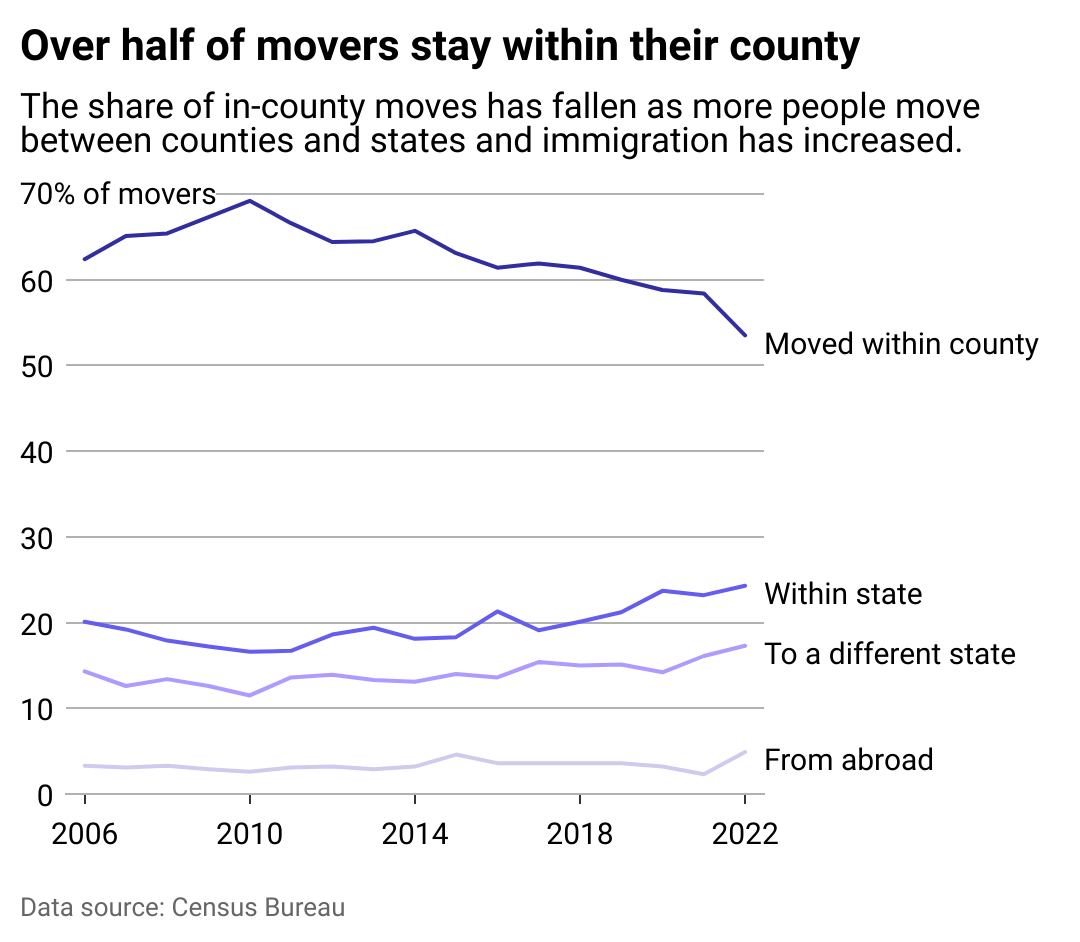Most people move homes within their county, but that number is shrinking

Shutterstock // My July
Most people move homes within their county, but that number is shrinking
A young couple in a kitchen surrounded by boxes. A woman is holding a packing tape and taping a large box on the floor while a man is sitting down on the counter next to a large pile of boxes looking at a phone in his hand.
In the 1950s and 1960s, about 20% of Americans moved each year. In 2022, that figure dropped to about 9%. The dramatic decrease over decades has continued in earnest over the past 15 years, driven largely by a drop among in-county movers.
In 2022, a little over 28 million people moved residences, down more than 10 million from 2007. Most of that drop was among people moving within their home county, comprising over half of yearly movers. That share has fallen substantially in recent years—especially in 2022, the most recent year measured, when the share of in-county movers dropped by about 5 percentage points in one year.
Spokeo analyzed relocation trends in recent years by examining data from the Census Bureau. A combination of factors is driving the drop in moves. Rising real estate prices are at the core of the decline of American mobility. Home sale prices across the country are at historic highs, as are rentals, and moving is costly. Mortgage rates, currently hovering around 7%, are also high relative to recent years. Meanwhile, a quarter of existing mortgages are locked in at rates under 3%, encouraging homeowners to stay in place.
The American population is also aging as baby boomers enter retirement. Older adults are less likely to move, though people of all ages and varied demographics are moving less often, according to a New York Times article. There has been a major dip in moves among younger adults, who have fewer motivations to move or seek out more space as they wait longer to get married or have children—if they do so at all.
![]()

Spokeo
As more Americans stay put, immigrants claim higher share of annual movers
A line chart showing the share of moves within counties, within states, across states, and from abroad. In-county moves have the highest share, but have begun to dip over the past few years.
Since 2007, the number of people moving has dropped by over 27%, with the number of same-county movers dropping by 40%. This rate most recently peaked in 2010, when nearly 7 in 10 people who moved did so within the county where they already lived. In 2022, just over half of movers are staying within their county.
The number of people moving within the same state also fell since 2007, while those moving out-of-state stayed about the same—though they each grew as a proportion of total movers as in-county moves waned.
Dramatically high costs in larger cities—traditionally attractive destinations among young, early career adults—also make these moving options less attainable. What’s more, urban jobs available to less-educated workers aren’t as advantageous as they once were and don’t pay enough to make up for the high costs of living.
The decline in moves overall somewhat contradicts the idea that people might move further after the COVID-19 pandemic due to the shift toward remote work. Still, those who did move chose places further from their original residence, granting the theory some credit. The rise in remote work also allowed more American job seekers to consider positions around the country and telecommute rather than pick up and move for a new job.
Close to 6 in 10 young adults live within 10 miles of where they grew up, according to a 2022 study by the Census Bureau and Harvard University. When expanding the radius to 100 miles, that share grows to 8 in 10 young adults. Younger adults moved further more often when offered higher wages, but more uniform economies across the country have somewhat diminished higher pay as an incentive to move.
The only major mobility increase was measured among those moving into the U.S. from abroad, which reached close to 1.4 million in 2022. That was a 15% increase over 2007, though growth has been inconsistent in that time. Immigration spiked over the past couple of years after pandemic-era restrictions eased. It is largely responsible for the country’s most recent population increase. In turn, immigration covers a larger share of moves among U.S. residents.
Fewer moves may mean more Americans are putting down roots and building community in the places where they’re from. People are being more intentional if and when they move. They are keeping their low-interest rate homes, saving money on big moves, and are less inclined to move solely for a job. Local wage growth and community investment is more likely to benefit longtime residents, providing more stability and connection among Americans and more balance across the national economy.
Story editing by Alizah Salario. Additional editing by Kelly Glass. Copy editing by Kristen Wegrzyn.
This story originally appeared on Spokeo and was produced and
distributed in partnership with Stacker Studio.